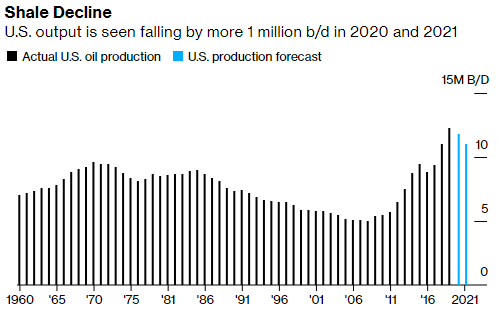The Energy Information Administration (EIA) revised its oil production forecasts in its April Short Term Energy Outlook due to the coronavirus pandemic and the “oil price war” for market share between Russia and Saudi Arabia. EIA now projects that U.S. crude oil production will average 11.8 million barrels per day in 2020, down 500,000 barrels per day from 2019, and 1.2 million barrels per day lower than its previous forecast. If this forecast is realized, the 2020 production decline would result in the first annual decline in U.S. oil production since 2016. The agency’s projection for oil production in 2021 is lower still at 11 million barrels per day, as it will take time for both demand and supply to recover. Saudi Arabia and other OPEC+ members want the United States to cut oil production, but the EIA forecast shows that the free market will force U.S. oil producers to lower production as some companies are already starting to shut in wells and as companies cut spending in response to low prices.
Crude oil prices have dropped significantly since the beginning of 2020, largely driven by the economic contraction caused by the coronavirus pandemic and a sudden increase in crude oil supply following the suspension of previously agreed upon production cuts among the Organization of the Petroleum Exporting Countries (OPEC) and partner countries. Despite the upcoming OPEC+ emergency meetings to discuss production levels, EIA assumed no re-implementation of an OPEC+ agreement through 2021 in this forecast since there was no agreement in place at the time the agency compiled the forecast.

U.S. Companies Cutting Production and Spending
Large, international oil companies and U.S. shale producers have collectively reduced budgets by tens of billions of dollars. Exxon Mobil is cutting its 2020 capital spending by 30 percent in response to the pandemic. The biggest portion of the $10 billion in cuts will be in the Permian Basin—the largest U.S. oil field in Texas and New Mexico. Other major oil firms are significantly reducing their budgets in response to the lower oil prices caused in large part by the coronavirus pandemic. Chevron, for example, is cutting spending by $4 billion, or 20 percent. Marathon Oil Corporation is reducing its capital spending to about half of its 2019 levels—a cumulative budget reduction of $1.1 billion.
Continental Resources, a large independent oil producer, is planning to cut production for April and May by about 30 percent—the same amount that global crude oil and product demand is estimated to have been impacted by the coronavirus pandemic.
OPEC+ Planning to Cut
OPEC and its allies met on April 9 to discuss the oil price and production situation. OPEC+ agreed to cut 10 million barrels a day—about 23 percent of their production levels—in May and June, according to an OPEC press release. The deal will last for two years with smaller cuts of 8 million barrels per day and 6 million barrels per day to follow. The press release indicated that the agreement is conditional on the consent of Mexico. Following the meeting, Mexico’s Secretary of Energy indicated that Mexico would be willing to cut production by 100,000 barrels per day for the next two months—less than the 400,000 barrels per day cut that OPEC+ wanted. The April 9th meeting of OPEC+ was followed by an April 10 meeting of the G-20 where market stability and the coronavirus pandemic were discussed.
EIA’s Oil Price Forecast
EIA expects Brent crude oil prices to average $33 per barrel in 2020—$10 per barrel lower than its previous forecast and lower than the average of $64 per barrel in 2019. In 2021, the agency expects Brent prices to average $46 per barrel—$10 per barrel lower than its previous forecast.
EIA’s World Demand Forecast
EIA estimates global liquid fuels consumption averaged 94.4 million barrels per day in the first quarter of 2020—5.6 million barrels per day lower than the same period in 2019. In 2020, EIA projects global liquid fuels demand will decrease by 5.2 million barrels per day from an average of 100.7 million barrels per day in 2019 and increase by 6.4 million barrels per day in 2021. The lower consumption forecast is because EIA expects significant disruptions to global economic activity and reduced global travel due to the coronavirus pandemic.

EIA’s U.S. Imports Forecast
EIA is forecasting that the United States will return to being a net importer of crude oil and petroleum products in the third quarter of 2020 and remain a net importer in most months through the end of the forecast period, which is a result of higher net imports of crude oil and lower net exports of petroleum products. Net exports of petroleum products are forecast to be lowest in the third quarter of 2020 as U.S. refinery runs are expected to decline significantly.

EIA’s Gasoline Price Forecast
For the April to September 2020 summer driving season, EIA expects U.S. regular gasoline retail prices to average $1.58 per gallon, down from an average of $2.72 per gallon last summer. The lower forecast gasoline prices are due to the lower forecasted crude oil prices and lower gasoline demand in the second quarter of 2020 resulting from the coronavirus travel restrictions and disruptions to domestic economic activity. EIA expects U.S. regular gasoline retail prices to average $1.86 per gallon in 2020 and $2.16 a gallon in 2021.
Conclusion
According to EIA’s forecast, the U.S. oil industry will not return to health until next year. Companies will be slashing budgets and cutting production to survive the downturn caused by the coronavirus pandemic. EIA expects U.S. oil production this year to 1.2 million barrels per day less than its previous forecast, totaling 11.8 million barrels per day with oil prices averaging $33 per barrel. The sooner the United States and the world recover from the economic contraction due to the coronavirus, the sooner demand for energy fuels will increase to make economic growth possible.



